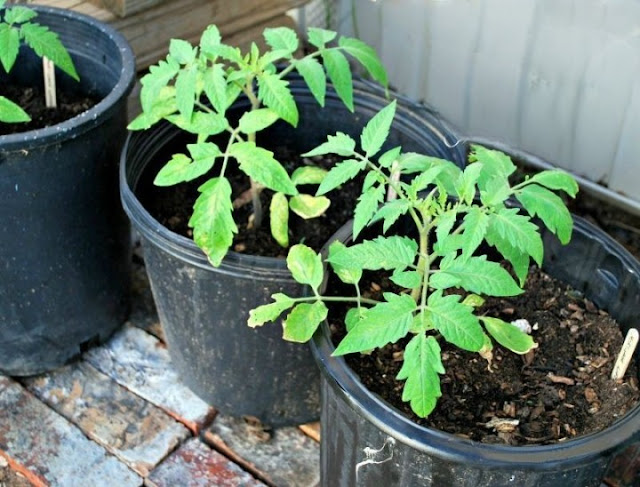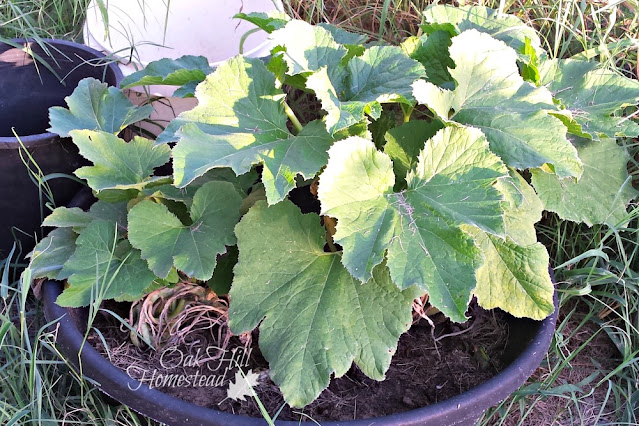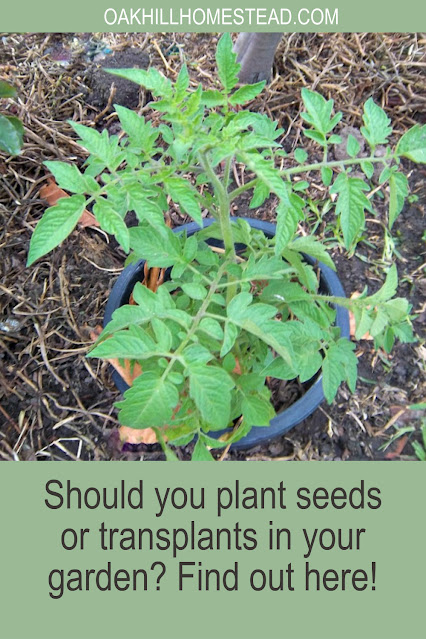Seed vs seedling: should you sow seeds in your vegetable garden or buy transplants instead? Learn the difference between cool season and warm season vegetable plants and whether they prefer direct seeding or to be transplanted into the garden.
Seed vs seedling
The difference between seeds and seedlings is quite simple. Seeds are small hard capsules with an embryonic plant inside.
Seedlings are seeds that have sprouted and grown into young plants.
In this case, we're talking about seeds that have been started in pots and grown in a controlled environment until the weather is warm enough to move those plants to the garden. Moving these plants is called transplanting.
Just so you know, this post may contain affiliate links, which means I receive commissions for purchases made through those links, at no cost to you. You can read my disclosure policy for more info.
Direct sowing seeds in your garden means that you prepare the soil, plant the seeds, and let them sprout right where you want them to grow.
What are transplants?
First, let’s look at transplants, those starter plants, also sometimes called seedlings.
A transplant is any young plant that was started from seeds and then moved to pots as they grew larger and needed more room to grow.
In fact, if you’ve grown plants from seeds and those seedlings are ready to move to the garden, they too are called “transplants,” but in this article we’re talking about transplants or starter plants that you buy at the store.
You might think that buying transplants is the easiest way to get your garden started, and, you know what? You’re right. It IS easy!
But sometimes you should plant seeds instead of transplants.
When to transplant seedlings - a word of warning
The most important thing you need to know about transplants is that even though they’re are available in the stores, the weather may not be warm enough yet for them to survive out in your garden.
Yes, you’ll find tomato plants on the shelves, but tomatoes and other warm-weather vegetable plants shouldn’t be planted until after all danger of frost has passed.
Warm weather plants like tomatoes can’t survive even a short, light frost, when the temperature falls even just a few degrees below freezing for even a short period of time.
They prefer warm temperatures, and tomatoes in particular won’t really begin to take off and grow until the nighttime temperature is above 55°F, so you really don’t need to be in a hurry.
But, you might want to go ahead and buy them when they show up on the store shelves and in garden centers, because the longer you wait, the smaller the selection will be. Just know that you’ll need to keep them indoors until the weather warms up a bit.
To be fair, you can protect these plants on nights when you’re expecting a light frost and they will probably survive, but that’s a topic for another post, like this one on when to transplant tomato plants.
Warm season vegetables
Warm season plants that can’t survive a frost include:
- Beans
- Cantaloupe and other melons
- Corn
- Cucumbers
- Eggplant
- Okra
- Peppers
- Sweet potatoes
- Squash and zucchini
- Tomatoes
- Pumpkins and watermelons
These are the plants that you’ll want to either buy as transplants or start indoors six weeks or so before your last frost.
Also it’s worth noting that many of these plants need a much longer growing season than the cool season plants we’ll talk about next.
So buying transplants for these (or starting them from seed indoors) will help you get a jump on the weather, especially if you have a relatively short growing season.
There are some exceptions to this general rule though. Some of these warm weather plants are better grown from direct-sown seed, like corn and beans.
Sweet potatoes are planted from "slips" grown from another sweet potato. You can read about starting your own sweet potato slips here.
I know, that’s a long list to remember, especially with the exceptions. I’ve put them into a printable list that you can download for free here.
Cool season vegetables
On the other side of the coin are the frost hardy, cool season plants that you can plant directly in the garden before the last frost, including:
- Peas
- Spinach
- Kale
- Arugula
- Lettuce
- Swiss chard
- Radishes
- Beets
- Turnips
- Onions
- Carrots
- Cabbage
- Broccoli
- Cauliflower
- Brussels sprouts
You can direct sow these seeds in your garden, whether you’re gardening in the ground, in containers, or in raised beds.
However, you can usually find cabbage, broccoli, cauliflower and Brussels sprouts transplants and perhaps a few others in the stores. These fall into that list of “cool season” plants, but they are also good candidates for growing from transplants if you wish.
Root vegetables - carrots and radishes and beets and so on - as a general rule, don’t like to be transplanted, so even if you find seedlings for sale, you might not want to buy them.
When you transplant root vegetable seedlings, moving them from their little pots into the garden soil, their roots are disturbed and they may not grow correctly or even form the bulb that we harvest and eat.
If you do try to transplant these into your garden, do so very carefully. Some people seem to have the “knack” and can grow these from started plants well, but they can be difficult.
Onions, even though they are a root vegetable, can be grown from onion sets or from onion plants instead of from seeds.
.
Is it better to start vegetables from seeds or plants?
My recommendation is to plant seeds for those cool weather crops, and buy transplants for the warm weather plants, especially if you are a new gardener.
Use transplants for those warm weather plants - the tomatoes and peppers and melons and so on. Take advantage of the convenience of these garden-ready vegetable plants to build your confidence and make gardening enjoyable.
Gardening has a learning curve, as any new venture does, and seed starting has its own learning curve too. Usually it’s best to take on one challenge at a time! I want you to enjoy growing your own healthy fruits and vegetables and not be overwhelmed.
Boost your confidence and make things simple and easy
There are several other comparisons when it comes to buying transplants vs growing your plants from seeds indoors, but the biggest consideration - and the one we’re discussing today - is your level of gardening experience.
Transplants are the easy way to get your garden started. As long as you don’t plant those warm season plants too early, growing your garden from transplants is simple and easy.
Basically, those cool season vegetables (with certain exceptions) should be direct sown from seeds, right in the garden or in the containers and pots you’ll use. They can be planted before your last frost and they generally have a short growing season.
You’ll find planting information on the back of the seed packets, including when to plant and how deep to plant the seeds.
Warm season plants, which are frost tender and can’t be planted until after the last spring frost, can be purchased as transplants, which is an easy way to start your garden.
If you don’t buy these as transplants, most of these plants should be started from seeds, indoors, about 4-6 weeks before the last frost in your area.
The exceptions to this general rule are corn and beans, which are best grown from seeds that are directly seeded in the garden.
Sweet potatoes are another plant that doesn't play by the rules. They are grown from “slips”, which are the plants that grow from the mother potato. You can buy sweet potato slips online, or you can buy an organic sweet potato at the grocery store, suspend it in a jar of water using toothpicks in February or so, and grow your own slips.
Buy healthy transplants - here's what to look for
When you’re browsing the garden center for transplants, be sure to look for healthy plants.
Healthy vegetable transplants are green and strong, not wilted, droopy or dried-up-looking.
Look for plants that are plump and full, not thin-stalked and spindly. Transplants that haven’t had enough light will look “leggy” and stretched, with too much space between the leaves, as though they are trying to reach for the sun.
Pick up the pots and test the weight. They should feel a bit hefty, not weightless, which could mean that the plants may not have been watered regularly and properly. These plants will be stressed, and sometimes the soil is so dry that it can’t absorb water when you take them home.
Stick your finger in the soil. It should be slightly damp, not so dry that the soil has shrunk away from the sides of the pots.
Choose transplants that are insect-free and don’t have spotted, sad-looking leaves. You don’t want to bring home insects or diseases to the rest of your plants. Check the underside of the leaves and look for bugs and insect eggs.
Healthy plants will transplant more successfully and will grow into healthy, beautiful plants that will produce healthy, tasty vegetables for you.
Remember that it might not be time to plant those warm weather transplants outside yet, even if they’re available in the stores. Keep them protected from the weather until all danger of frost in your garden is over before you plant them outside.
Free transplant shopping list
To help you keep it all straight, I’ve put together a printable list of all these plants and which category they fall into, which you can download for free here.
You can print this list and take it to the store or garden center to help you remember what to buy: seeds or transplants.
Click here to download the free printable list of all the plants I’ve mentioned in this episode: the cool season plants, the warm season plants, those that are best started from seeds in the garden and the garden-ready plants that you can purchase as transplants for an “instant garden” as well as the inevitable exceptions to the rules.
My mission is to inspire and encourage you to live a simple, joyful life,
no matter your circumstances or where you live. Join me here:
Facebook | Pinterest | Instagram | Subscribe



















